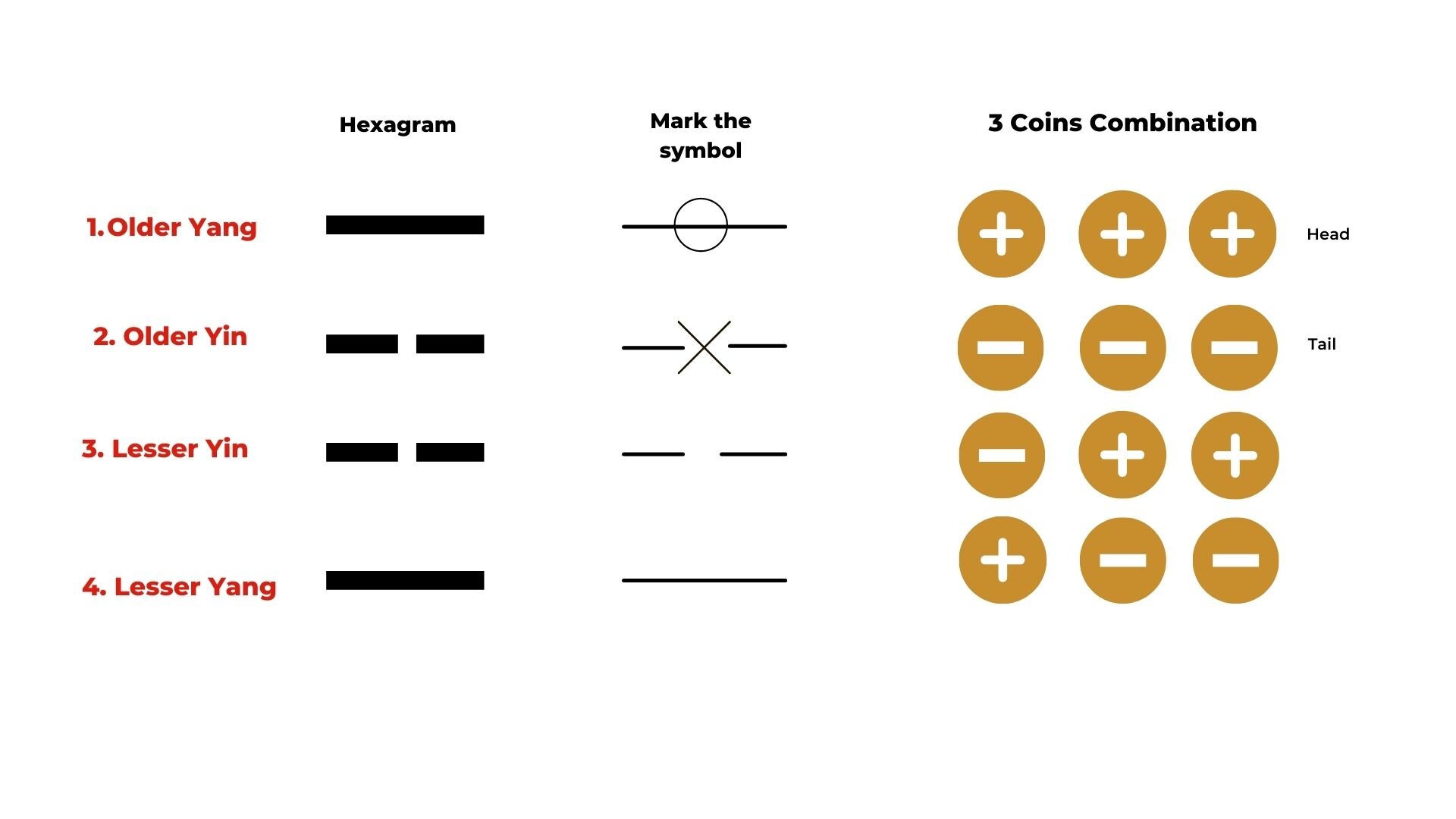I Ching divination with 3 coins
/I-Ching divination with the 3 coins method
How to use 3 coins to find your I-Ching hexagram as the first step of the I-Ching divination? The three coins drawing method is one traditional Chinese fortune-telling technique everybody can learn. We are going to show you the process of how to come up with your unique I-Ching hexagram with the basic three coins method.
The 3-coins method is one of many ways to draw the particular I-Ching Gua (Kua) from the 64 hexagrams. By throwing the 3 coins, you come up with one of the 6 lines of the hexagram. And then we can refer to an I-Ching book to interpret the meaning of the hexagram. That is the basis of how your questions are answered.
Read more about I-Ching divination basics from our previous post here.
Watch our video of the 3 coins method for I-Ching divination
What kind of coins to use
For the purpose of I-Ching fortune-telling, any coin will work. If it has special meaning to you, it will be more powerful. Some people like to use ancient Chinese coins, but any coin will work. You can certainly pick your country’s coins. If you are in the US, the quarters will work fine.
The coin has to have 2 different sides. Usually, the side with the head is the Yang (positive) side, and the tail/back is the Yin (negative side). If it is not clear, you can decide which side is the top, and stick with that.
Once you pick out the coins, it is a good idea to use them for fortune-telling purposes only and keep them separate from regular spending coins. Clean them first with water or incense to avoid any interference from previous energy. If possible, you can perform a ritual or prayer before start using them to enhance the sensitivity.
The I Ching basics
Below is the 64 I Ching hexagrams. They come from the Bagua or the eight trigrams. Each of the Bagua consists of 3 lines. Each line is either Yin (a broken line), or Yang (a solid line).
Each Bagua symbol has related meaning, direction, number, family member, and so on. That is the basis of how to interpret the hexagrams (6 lines Gua).
With the 3 coins method, the purpose is to draw an I Ching hexagram out of the 64. It can include the changing lines and the whole hexagram will change into a new hexagram for the future outcome. Sometimes there will be no changing lines so you can interpret directly from the original hexagram.
How to use the coins and mark the symbols
We are showing the 4 combinations of the 3 coins below. Once you focus on your question and throw the 3 coins, you get one of the 4 combinations.
If you get 4 heads or positives, you can mark the symbol of a solid line with a circle. It means the older Yang or greater Yang, and it shows as a solid line (Yang) in the hexagram.
If you get 3 tails or negatives, you can mark a broken line (Yin) with an X. It means the older Yin or greater Yin, and it shows as a broken line (Yin) in the hexagram.
Both the older Yang and older Yin are changing lines. The changing lines mean the lines will be reversed to come up with a new hexagram. The solid line (Yang) will become a broken line (Yin) and the broken line (Yin) will become a solid line (Yang).
If you get 2 heads and 1 tail, mark the symbol as a broken line (Yin), and the final symbol will be the same broken line (Yin). It is the lesser Yin.
If you get 2 tails and 1 head, mark the symbol as a solid line (Yang), and the final symbol is the same (solid line or Yang). It is the lesser Yang.
For the lesser Yin and lesser Yang, they are not changing lines.
(* Please note the slide in the YouTube video has a mistake, the broken line is the lesser Yin and not lesser Yang, and the solid line is the lesser Yang, not lesser Yin. Sorry! The slides below are corrected.)
The changing lines
When there is too much Yang, it will change into Yin. When there is too much Yin, it will change into Yang in the future. So the Older Yang will become Yin, and the older Yin will become Yang.
If there is a changing line (older Yang or older Yin), there will be a new hexagram after the changing lines. The first (original) hexagram represents your current situation, and the second (changed) hexagram represents the future and outcome.
Example
Here is an example of the hexagram with the 3 coins method. We always start with the bottom line or the first Yao and go up. The first time you throw the 3 coins, record the result at the bottom (first Yao), and the second time you throw the coins, record the result as the second Yao. Keep repeating the process for all six lines.
For example:
The first combination is 2 heads and 1 tail. You mark a broken line (Yin).
The second combination is 3 tails. You mark a broken line with an X (changing Yin). This will be changed to a solid line (Yang) in the second hexagram.
The third combination is 1 head and 2 tails. You mark a solid line (Yang).
The fourth combination is 2 heads and 1 tail. You mark a broken line (Yin).
The fifth combination is 3 tails. You mark a broken line with an X (changing Yin). This will be changed to a solid line (Yang) in the second hexagram.
The sixth combination is 3 heads. You mark a solid line with a circle (changing Yang). This will be changed to a broken line (Yin) in the second hexagram.
Now you can see the final 2 hexagrams. The one on the left is the original hexagram showing the current situation. The one on the right is the second hexagram after the reverse of the changing lines. This will indicate the future outcome of your questions.
After coming up with the hexagram, you can refer to an I-Ching book and find the meaning of that hexagram in relation to your question. This is the basic way to do an I Ching divination or fortune-telling.


























